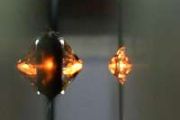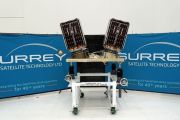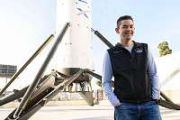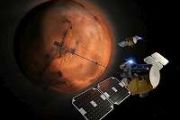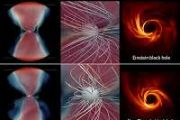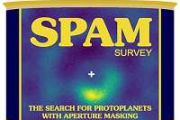
Copernical Team
Data suggests there are rippled structures at the boundary of the solar system
Orbital Sidekick selected as partner for Intelligent Pipeline Integrity Program (iPIPE)
 Orbital Sidekick (OSK), the first U.S. commercial company to deploy hyperspectral sensors in space, has been selected once again by the intelligent Pipeline Integrity Program (iPIPE) to serve as the company's technology partner. OSK will have an opportunity to advance its Global Hyperspectral Observation Satellite constellation known as GHOSt, which is set to launch in 2023. The hyperspectral im
Orbital Sidekick (OSK), the first U.S. commercial company to deploy hyperspectral sensors in space, has been selected once again by the intelligent Pipeline Integrity Program (iPIPE) to serve as the company's technology partner. OSK will have an opportunity to advance its Global Hyperspectral Observation Satellite constellation known as GHOSt, which is set to launch in 2023. The hyperspectral im GMV joins UN Global Compact
 As a declaration of its firm commitment to innovation-led, progress-seeking sustainable development, technology multinational GMV has joined the United Nations Global Compact, a worldwide initiative. With this step, GMV takes up and assumes the legacy of one of its subsidiaries, which joined the Global Compact in 2014.
The Global Compact is the world's leading corporate sustainability init
As a declaration of its firm commitment to innovation-led, progress-seeking sustainable development, technology multinational GMV has joined the United Nations Global Compact, a worldwide initiative. With this step, GMV takes up and assumes the legacy of one of its subsidiaries, which joined the Global Compact in 2014.
The Global Compact is the world's leading corporate sustainability init Trimble's new agriculture displays provide next-generation performance and connectivity for in-field operations
 Trimble (NASDAQ: TRMB) has introduced its next-generation displays for precision agriculture applications-the Trimble GFX-1060 and GFX-1260 displays. Trimble's portfolio of innovative displays enables farmers to complete in-field operations quickly and efficiently while also mapping and monitoring field information in real time with precision. With a range of functionality and price points, farm
Trimble (NASDAQ: TRMB) has introduced its next-generation displays for precision agriculture applications-the Trimble GFX-1060 and GFX-1260 displays. Trimble's portfolio of innovative displays enables farmers to complete in-field operations quickly and efficiently while also mapping and monitoring field information in real time with precision. With a range of functionality and price points, farm SIMBA Chain awarded SpaceWERX Orbital Prime Contract
 SIMBA Chain announces it has been selected by SpaceWERX for a STTR Phase I in the amount of $250,000 to investigate how SIMBA's blockchain technology may enable In-space Service Assembly and Manufacturing (ISAM) capabilities being explored by the Department of the Air Force (DAF) and United States Space Force (USSF) through the Orbital Prime program. Orbit
SIMBA Chain announces it has been selected by SpaceWERX for a STTR Phase I in the amount of $250,000 to investigate how SIMBA's blockchain technology may enable In-space Service Assembly and Manufacturing (ISAM) capabilities being explored by the Department of the Air Force (DAF) and United States Space Force (USSF) through the Orbital Prime program. Orbit Impact that killed the dinosaurs triggered "mega-earthquake" that lasted weeks to months
 Denver, Colo., USA: 66 million years ago, a 10-kilometer asteroid hit Earth, triggering the extinction of the dinosaurs. New evidence suggests that the Chicxulub impact also triggered an earthquake so massive that it shook the planet for weeks to months after the collision. The amount of energy released in this "mega-earthquake" is estimated at 1023 joules, which is about 50,000 times more energ
Denver, Colo., USA: 66 million years ago, a 10-kilometer asteroid hit Earth, triggering the extinction of the dinosaurs. New evidence suggests that the Chicxulub impact also triggered an earthquake so massive that it shook the planet for weeks to months after the collision. The amount of energy released in this "mega-earthquake" is estimated at 1023 joules, which is about 50,000 times more energ Northrop Grumman-built commercial telecommunications satellites launched successfully
 The Galaxy 33 and Galaxy 34 C-band satellites built by Northrop Grumman Corporation (NYSE: NOC) were successfully launched yesterday aboard a SpaceX Falcon 9 rocket from Cape Canaveral Space Force Station in Florida. The satellites, based on Northrop Grumman's flight proven GEOStar platform, were built for Intelsat and designed for 15 years of on-orbit life.
"Our GEOStar-3 satellite bus is
The Galaxy 33 and Galaxy 34 C-band satellites built by Northrop Grumman Corporation (NYSE: NOC) were successfully launched yesterday aboard a SpaceX Falcon 9 rocket from Cape Canaveral Space Force Station in Florida. The satellites, based on Northrop Grumman's flight proven GEOStar platform, were built for Intelsat and designed for 15 years of on-orbit life.
"Our GEOStar-3 satellite bus is Intelsat announces successful launch of Galaxy 33 and Galaxy 34 satellites
 Intelsat, operator of the world's largest integrated satellite and terrestrial network and leading provider of inflight connectivity, announced the successful launch of Galaxy 33 and Galaxy 34, geosynchronous communications satellites that will ensure service continuity to Intelsat's North American media customers. The Northrop Grumman-manufactured Galaxy 33 and Galaxy 34 satellites launched abo
Intelsat, operator of the world's largest integrated satellite and terrestrial network and leading provider of inflight connectivity, announced the successful launch of Galaxy 33 and Galaxy 34, geosynchronous communications satellites that will ensure service continuity to Intelsat's North American media customers. The Northrop Grumman-manufactured Galaxy 33 and Galaxy 34 satellites launched abo Cables, tie-wraps and no step
 The third (pictured) and fourth European Service Modules are currently in production at Airbus facilities in Bremen, Germany. They are a key element of the Orion spacecraft, the first to return humans to the Moon since the 1970s.
These modules provide the spacecraft with propulsion, power and thermal control, and will supply astronauts with water and oxygen. The Orion spacecraft is compose
The third (pictured) and fourth European Service Modules are currently in production at Airbus facilities in Bremen, Germany. They are a key element of the Orion spacecraft, the first to return humans to the Moon since the 1970s.
These modules provide the spacecraft with propulsion, power and thermal control, and will supply astronauts with water and oxygen. The Orion spacecraft is compose JPL's Venus Aerial Robotic Balloon Prototype Aces Test Flights
 A scaled-down version of the aerobot that could one day take to the Venusian skies successfully completed two Nevada test flights, marking a milestone for the project.
The intense pressure, heat, and corrosive gases of Venus' surface are enough to disable even the most robust spacecraft in a matter of hours. But a few dozen miles overhead, the thick atmosphere is far more hospitable to rob
A scaled-down version of the aerobot that could one day take to the Venusian skies successfully completed two Nevada test flights, marking a milestone for the project.
The intense pressure, heat, and corrosive gases of Venus' surface are enough to disable even the most robust spacecraft in a matter of hours. But a few dozen miles overhead, the thick atmosphere is far more hospitable to rob 



